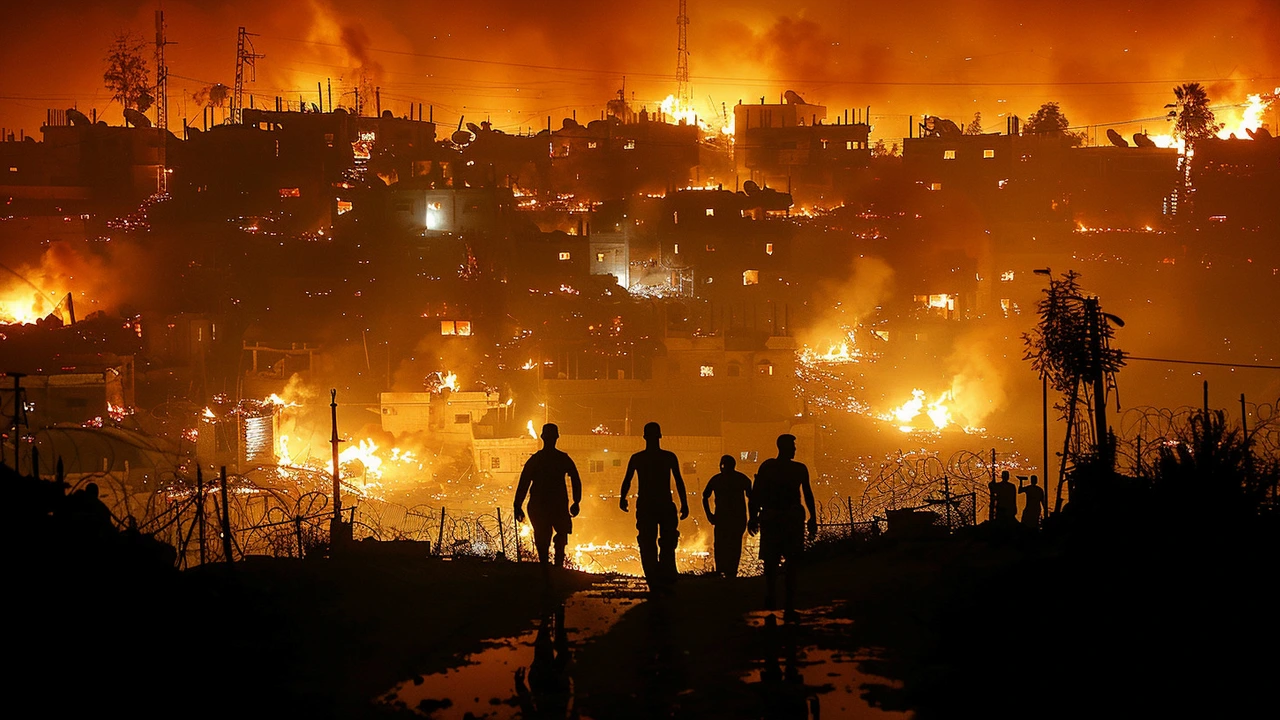Devastating Aftermath of Rafah Camp Strike
A recent strike on the Rafah refugee camp has left a deep scar on the heart of Gaza. According to Gazan officials, at least 45 individuals lost their lives in the horrific incident. The strike, which rocketed the camp into chaos and destruction, has been widely documented, with videos surfacing online that show the grim reality on the ground.
The footage offers a raw look at the aftermath, revealing a landscape ravaged by flames and strewn with debris. The searing images of smoldering ruins and anguished survivors paint a grim picture of the extent of the devastation. Families have been shattered, and the fabric of the camp's community torn apart. Rescue operations continue as search and recovery teams dig through the rubble, hoping to find survivors amid the wreckage.
Impact on the Community
The Rafah camp has long been a place of refuge, housing thousands of displaced individuals seeking safety from the cyclical violence that plagues the region. This strike, however, has turned the sanctuary into a battlefield, significantly impacting the lives of those who hoped for peace within its confines. Many survivors have recounted stories of terror and loss, their lives forever altered in mere moments.
Children, often the most vulnerable in such conflicts, are heavily represented among the casualties. The emotional and psychological toll on the young inhabitants is profound, with many struggling to comprehend the sudden and violent upheaval of their world. Communities now face the monumental task of rebuilding not only their homes but also their sense of security and trust.
Documenting the Horror
CNN's Jeremy Diamond has been at the forefront of reporting on this incident, bringing the harrowing scenes to the global audience. His firsthand accounts and the accompanying video footage have been crucial in documenting the scale of the atrocity. The visuals, though difficult to watch, serve as a powerful reminder of the human cost of the ongoing Gaza-Israel conflict.
The graphic nature of the videos has sparked waves of empathy and anger worldwide. Social media has played a significant role in disseminating the images, leading to a surge in calls for international intervention and peace negotiations. Many prominent figures and citizens have taken to various platforms to express their horror at the violence and advocate for immediate ceasefires.

Context of the Conflict
The Rafah camp strike is not an isolated incident but a part of the larger, protracted conflict between Israel and Gaza. This battle has been marked by a series of violent exchanges, resulting in significant casualties on both sides. The recent escalation in hostilities has renewed fears of an even bloodier and prolonged confrontation.
The cyclical nature of the violence in this region has created a seemingly inextricable series of retaliations and provocations, each incident inflaming tensions further. For many civilians, each day is fraught with uncertainty and danger, as they navigate life under the shadow of violence. Efforts for peace and reconciliation have frequently been undermined by fresh outbreaks of hostility, creating a persistent state of crisis.
Global Response and Calls for Peace
The international community has reacted with widespread condemnation of the Rafah camp strike. Numerous countries, humanitarian organizations, and human rights groups have called for an immediate cessation of hostilities. The United Nations has reiterated its calls for peace, emphasizing the need for both sides to come to the negotiating table.
In the wake of the strike, there has been a notable uptick in diplomatic efforts aimed at de-escalation. Various parties have stepped up their mediation attempts, hoping to broker a truce that can pave the way for sustained peace. However, skepticism remains high, given the historical context of broken ceasefires and unfulfilled promises.
The Humanitarian Crisis
The continuous violence has exacerbated an already dire humanitarian crisis in Gaza. Infrastructure, including hospitals and schools, has been severely damaged, complicating efforts to provide essential services to the population. The recent strike on Rafah has further strained these fragile systems, stretching resources to their limits.
Humanitarian aid organizations are facing significant challenges in delivering aid due to the ongoing conflict. Restrictions on movement and the constant threat of violence have hampered their operations. Nonetheless, they persist, driven by the urgent need to provide relief to those affected by the conflict. The international community has been called upon to increase support for these efforts, ensuring that aid reaches those in need.

An Urgent Need for Resolution
The Rafah camp strike is a stark example of the urgent need for a resolution to the Gaza-Israel conflict. The human toll of the violence is unignorable, with each incident adding to the growing chorus of voices demanding peace. The international community must redouble its efforts to support meaningful negotiations and initiatives that can break the cycle of violence.
For the families and individuals affected by the strike, the road to recovery will be long and arduous. As they pick up the pieces of their shattered lives, the call for justice and accountability grows louder. Their stories and experiences serve as a poignant reminder of the costs of conflict and the pressing need for lasting peace in the region.
Conclusion
The strike on the Rafah refugee camp is a tragedy of immense proportions, highlighting the devastating human cost of the Gaza-Israel conflict. The graphic videos and eyewitness accounts provide a sobering glimpse into the suffering endured by civilians caught in the crossfire. As the world watches, there is hope that the international outcry will lead to tangible actions and renewed efforts for peace.
Ending the cycle of violence is paramount to ensuring a future where such tragedies are a thing of the past. The voices of the affected and the global community must continue to push for a resolution, emphasizing the urgent need to protect innocent lives and foster a lasting peace in the region.






15 Comments
Mitch Roberts
May 30, 2024 AT 00:17 AMThis is why we need to stop pretending this is about 'security'-it's just endless cycle of violence with civilians paying the price. My heart is with those families. 🙏
Steve Cox
May 31, 2024 AT 15:30 PMLet's be real-no one cares about the dead unless there's a video that goes viral. The same people screaming about Rafah ignored the 200 killed in Khan Younis last month. Performative outrage is all this is.
Emily Nguyen
May 31, 2024 AT 19:33 PMI'm tired of Western media acting like this is the first time civilians have died in Gaza. You think Israel's the only one with drones? Where's the outrage when Hamas launches rockets into schools? Double standards are exhausting.
Gabriel Clark
June 2, 2024 AT 04:43 AMThe footage is harrowing. But let’s not reduce this to a binary. Both sides have committed atrocities. The path forward isn’t more bombs-it’s sustained diplomacy, accountability, and lifting the blockade. Peace isn’t a slogan-it’s a structure.
ria ariyani
June 2, 2024 AT 22:16 PMI mean... why are we even surprised? Like, of course the camp got hit-everyone knows it's a Hamas hub. They hide under kids. It's not rocket science. 🤷♀️
Prakash.s Peter
June 3, 2024 AT 21:23 PMThe structural violence of occupation-when institutionalized through legal, economic, and spatial mechanisms-creates conditions wherein civilian casualties become statistically inevitable, not anomalous. This is not 'collateral damage.' It's policy.
Harry Adams
June 5, 2024 AT 05:46 AMI'm genuinely shocked that anyone still defends this as 'self-defense.' The precision-guided munitions used here weren't targeting militants-they were erasing neighborhoods. This isn't war. It's urban cleansing disguised as counterterrorism. And the media's complicity? Unforgivable.
Mark Venema
June 6, 2024 AT 20:44 PMThe humanitarian infrastructure in Gaza is collapsing. Hospitals without power, water systems destroyed, food aid blocked. This isn't just a tragedy-it's a systemic failure of international law. We must demand the ICJ enforce its provisional measures. Now.
Aaron Leclaire
June 7, 2024 AT 15:44 PMStop.
Rishabh Sood
June 8, 2024 AT 16:41 PMThe metaphysical weight of this suffering transcends geopolitics. Each child buried beneath rubble is not merely a statistic-they are a rupture in the moral fabric of our shared humanity. To look away is to become complicit in the erosion of conscience.
Saurabh Singh
June 9, 2024 AT 01:08 AMYou think the UN gives a damn? They've been useless for 75 years. This is why real change comes from armed resistance-not petitions. Hamas didn't start this war. They're just the only ones who still fight back.
Brian Walko
June 10, 2024 AT 06:36 AMI've been volunteering with aid convoys near the border. The desperation is beyond words. People are eating grass. Children are dying from dehydration. We need global pressure-not just hashtags. Call your reps. Demand a ceasefire. Now.
Derrek Wortham
June 11, 2024 AT 23:08 PMYou know what’s worse than the strike? The fact that you’re all still arguing about who’s right while kids are still under the rubble. Someone’s got to go in there and pull them out-not write essays. Get off your screens and DO something.
Mali Currington
June 13, 2024 AT 16:10 PMOh wow, another 'heartbreaking' video. Next week it’ll be the 10th one this month. I’m sure the people in Rafah are just thrilled to be trending on TikTok. 🙃
Elizabeth Price
June 14, 2024 AT 22:57 PMLet’s not pretend this is about peace. Israel is defending itself against an organization that openly calls for its annihilation. You can’t negotiate with people who want you gone. And yes, that means civilian areas get hit-because they’re not civilians, they’re terrorists in disguise.